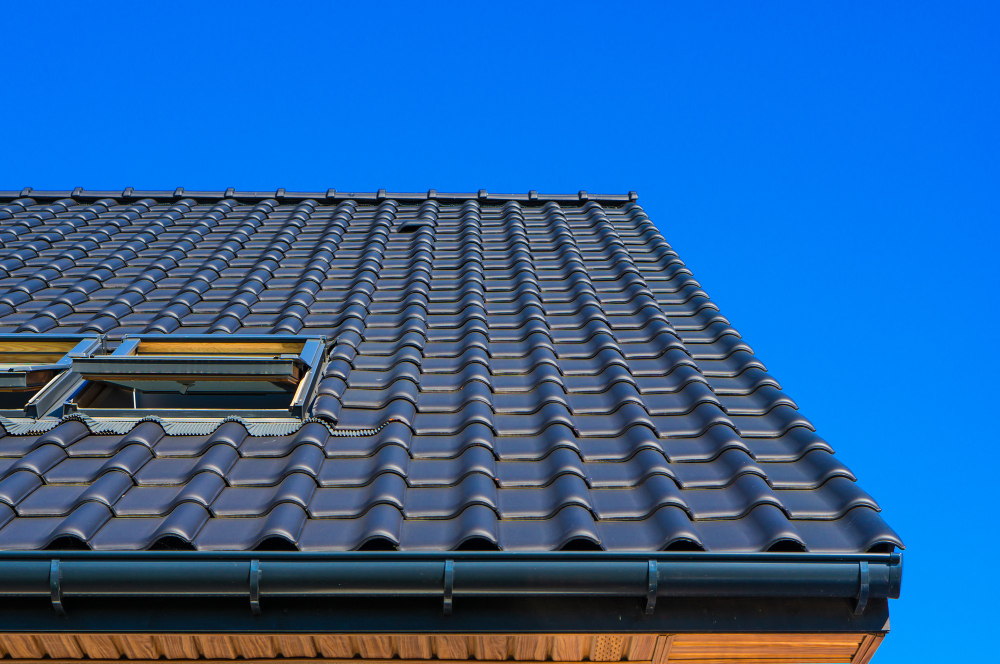In addition, all types of commercial roofs need to be vented properly or incorporate air vents into the roof construction. However, factors that determine the roof for your home, such as climate, budget, and energy efficiency play a role!
This comprehensive guide on industrial roofs will cover:
- Common commercial roof types
- Their advantages and disadvantages
- The appropriate setting for each roof
Flat Roofs
From all types of roofs on commercial buildings, flat roofs are easier to notice, because they feature minimal slope, and it is often less than 10 degrees, just to prevent the water from pooling on the roof. These roofs are the most common industrial roof types because they offer great value for the money and need only minimal maintenance. Because flat roofs have been around for decades, you can find quality roofing companies to install them, especially in urban areas such as Crestview and Pensacola.
When they are made from reflective materials, they can improve resistance to sun heat and UV rays. That way, the roof keeps the building cooler and minimizes electricity bills, which is a considerable saving on industrial space.
A flat roof can last a few decades, which makes it excellent for businesses looking for long-lasting solutions.
Advantages:
- Cost-effective
- Straightforward to install and maintain
- Installing HVAC units and solar panels is simple due to flat construction
- A flat roof provides additional space that can be converted into a storage section
Disadvantages:
- Potential issues with drainage
- It requires a skilled architect to design the roof with minimal water-pooling issues
Best For:
- Large commercial buildings, warehouses, and manufacturing facilities.
Metal Roofs
Metal roof systems have numerous benefits for both commercial and residential settings. They are made from durable materials, steel and aluminum, and less often copper. If you take a look at some older commercial roof construction types in Florida, you’ll notice a lot of them are metal roofs.
The life expectancy is beyond 50 years, and for that time, a roof withstands harsh weather, and fire and improves the energy efficiency of the building.
Because of the relatively simple constructions, metal roofs are quick to install and often choice number one for industries looking to put the plants into operation as soon as possible. In addition, environmentally conscious businesses turn to metal roofing, because they are recyclable, need fewer repairs over time, and produce less waste.
Advantages:
- Excellent life expectancy – over 50 years
- Fire-resistant
- Improve the energy efficiency of the building
- Environmentally-friendly
- Low-maintenance
- Straightforward installation
Disadvantages
- Noisy during harsh weather, especially without a proper insulation layer
- Expensive
Best For
- Industrial buildings, shopping centers, airports, railways and bus stations, educational and healthcare facilities, commercial buildings in areas prone to severe weather.
TPO (Thermoplastic Olefin) Roofs
In recent years, TPO roofs have gained more popularity because of their versatile use and energy efficiency. TPO stands for Thermoplastic Polyolefin, and it is a white roofing membrane that consists of a unique blend of rubber and several fillers.
Most commonly, fillers are talc and fiberglass, chosen for their ability to improve material flexibility and durability. These membranes come premanufactured in sheets 10, 12, and 20 feet wide. It makes material transport simple and the installation process quick.
The membrane is white, so there is no need to add another layer of reflective sealant to improve heat resistance. However, if cracks and tears appear, applying sealant is one way to improve roof lifespan. It makes it an excellent choice for areas with extreme weather and heavy industrial activity with a risk of fires.
Advantages:
- Long lifespan – 20 – 30 years
- Excellent energy efficiency
- Straightforward and installation and maintenance
Disadvantages:
- Can shrink over time,
- Material deterioration causes brittleness
- Susceptible to punctures and tears
Best For:
- Commercial buildings in areas with harsh weather and buildings that prioritize energy efficiency
EPDM (Ethylene Propylene Diene Monomer) Roofs
Ethylene Propylene Diene Monomer, short EPDM roofs stand out among various types of roofs for commercial buildings for their lower price tag and simple maintenance. EPDM roof is also called rubber roof and is applied on low slope commercial roof types.
The roofing EPDM membrane consists of ethylene and propylene and comes in black and white. Unlike other synthetic membranes, EPDM comes in a large range of membrane widths and thicknesses. Often, the EPDM membrane is reinforced with different add-ons such as fiberglass mats, to improve the roofing features and longevity.
Experienced roofers install an EPDM roof either by fully adhering it to the low-slope roof or by attaching it with adhesive seams or tape. The performance of the roof depends vastly on the successful installation, which means you need to find trusted and experienced roofers to handle installation on commercial buildings.
Advantages:
- Long-lasting
- Cost-effective solution for large buildings
Disadvantages:
- Inadequate installation significantly compromises the roof performance
- Prone to punctures and UV damage if the membrane isn’t reinforced with appropriate fillers
- Poor aesthetic
Best for:
- Industrial buildings with large roof surfaces and office buildings, coworking spaces
Modified Bitumen Roofs
Modified bitumen roofs or short mod bit aren’t new and modern commercial building roof types, but they have passed the test of time. Now, they have been improved to become a cost-effective solution for a variety of commercial buildings.
In fact, in recent years, modified bitumen roofs have been on top of lists of industrial building roof types for low-slope commercial low-slope designs.
This multilayer roofing is a combination of asphalt membrane and polymerized rubber, rarely plastic. To enhance its roofing features, manufacturers add fiberglass which aids durability, and resistance and simplifies installation by making the material easier to handle. Still, it requires highly qualified roofers for successful installation.
Two ways of installation are the peel-and-stick method and torch down. The first one is cheaper but less reliable. The torch-down installation method provides better water protection and makes it a preferred choice for businesses in areas with harsh climates.
Therefore, places in Florida, such as Niceville with a lot of rain, and Milton, with high hurricane risk, favor this roof type over other roof types for commercial buildings.
Advantages:
- Excellent for low and high temperatures
- Simple maintenance
- Excellent protection because of the multilayer structure
Disadvantages:
- Shorter lifespan compared to other materials,
- Susceptible to blistering and cracking over time
- Expensive to install on large buildings
Best For:
- Small to medium-sized commercial buildings, retail spaces, and offices.
Built-Up Roofing (BUR)
BUR roof or built-up roof is a complex system of several layers of bitumen, as the primary material and additional layers are chosen carefully to enhance the bitumen protection features.
These multi-layer roofing systems can be installed differently, but typically, the base layer comes over insulating rigid foam boards. It becomes an adequate, waterproof base which allows additional layers to be installed, often with hot asphalt.
One by one, protective layers are applied in a tedious way, which is time-consuming but highly effective, sturdy, and durable. On top of the built-up roof, your contractor may install a mineral surface sheet or cover it with gravel.
Gravel is a good choice for Pace and other sunny areas in Florida because it prevents the heat from penetrating the underlayers. If the roof is designed to be used and has a lot of foot traffic, gravel also provides better grip.
Advantages:
- Waterproof
- Long-lasting, because if one layer gets damaged, the layer under keeps the building protected
- Roofing comes with long-lasting warranties
- Almost zero-maintenance
Disadvantages
- Expensive installation
- Roof performance depends on the installation
- Due to multiple layers, the roof is heavy and needs extra support to remain stable
- Long and monotonous installation
Best For
- Large commercial buildings, industrial facilities, and warehouses.
Conclusion
Different types of commercial roofs are suited for various industrial applications, but most modern roof systems are energy-efficient and provide solid weather protection. Built-up roof systems are excellent choices for huge large roofs, and modified bitumen roofs are good alternatives to them for mid-sized facilities.
Metal roofs are a solid option for environmentally conscious companies, while EPDM and TPO roofs stand out with their straightforward installation and excellent value for the money.
For all commercial roof inquiries, Emerald Coast Roofing is there to help you!
FAQ
What is the most cost-effective commercial roofing option?
The cost-effectiveness of your chosen roofing system depends on the size and complexity of the building as well as weather factors that can contribute to material deterioration. Metal roofs pay out in the long run because of their excellent lifespan, but TPO and EPDM roofs can be less expensive to install.
- Which commercial roof type has the longest lifespan?
Metal roofs can last over half a century without compromising any of the protection and functionality features.
- Can commercial roofs be environmentally friendly?
Solar panels installed on different types of commercial roofs are a practical way to improve the impact of commercial roofs on the environment. Also, metal roofs from aluminum copper, and zinc are recycled.
- Can you put solar panels on every commercial roof?
Yes, experienced roofing contractors will find a solution for solar panels on all industrial roof types, but some may be more complex and expensive. But, if the commercial building’s flat roof is used as a storage section or holds heavy ventilation units, solar panels might not be an option.






